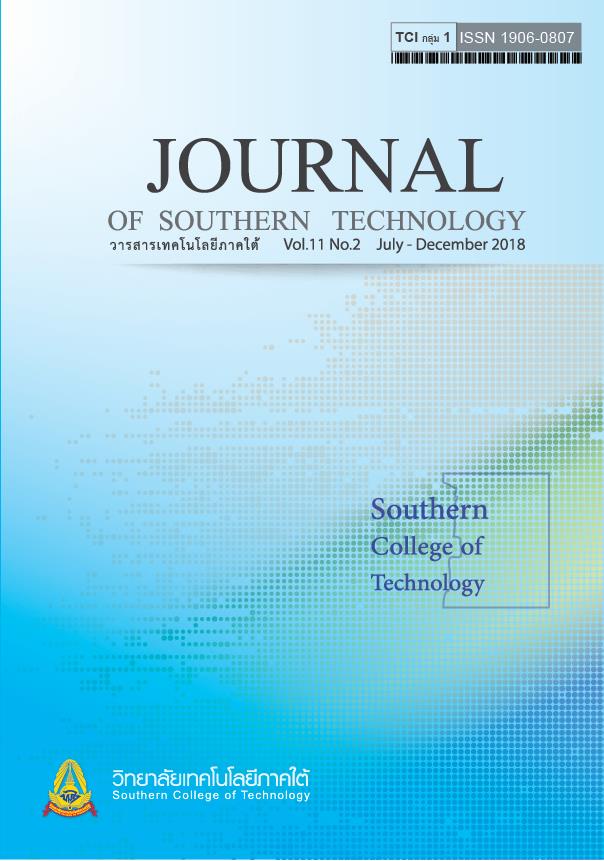Economic Utilization from Sago Palm Trees of Community in Nakhon Si Thammarat Province.
Main Article Content
Abstract
The objectives of this research were to analyze cost-benefit characteristics of the Sago palm trees in Nakhon Si Thammarat province in Thailand and to investigate appropriate utilization of Sago palm trees. Both quantitative and qualitative methods were used in this research. A total of 30 Sago palm tree harvests in 5 districts in Nakhon Si Thammarat province ; Ron Phibun, Cha-uat, Chaloem Pra Kiat, Mueang and Phrom Khiri district were interviewed based on purposive sampling technique. Content Analysis was used with qualitative analysis.
The result of cost-benefit analysis which classified trees by age and type of utilization based on three classes of Sago palm trees by age group: a) younger than 4 year-old; b) 4–8 year-old; and c) more than 8 year-old are classified. There is no utilization of the first group. While there are two utilizations of the second group: (1) raw Sago palms are crushed to manufacture general animal feedstuffs which there are average income, average cost, and average profit is 1,600 baht, 700 baht, and 900 baht per tree, respectively; (2) raw Sago palms are crushed for feeding Sago grubs which there are average income, average cost, and average profit is 12,000 baht, 760 baht, and 11,240 baht per tree, respectively. For the last group, there are two utilizations: (1) making Sago palm starch which there are average income, average cost, and average profit is 45,000 baht, 700 baht, and 3,800 baht per tree, respectively; (2) feeding Sago grubs which there are average income, average cost, and average profit is 31,500 baht, 860 baht, and 30,640 baht per tree, respectively. However, there is utilization of 4-12 year-old Sago palm trees to make a thatched roof by its leaves. Their average income, average cost, and average profit is 1,500 baht, 200 baht, and 1,300 baht per tree per year, respectively. The value of 4-12 year-old Sago palm trees can generate profit of 10,400 baht per tree. In terms of appropriate Sago palm tree utilization, 8-12 year-old sago are the most useful by providing the most productive with included good quality and quantity. Moreover, 4-12 year-old Sago palm leaves are used for making roofs and wickers. However, useful of 4-8 year-old of Sago palm trees provide a little productive and cutting of younger than 4 year-old Sago palm trees do not have economic value and also reduce Sago palm forest area. Therefore, result of the study is contributed to community where utility from Sago palm trees with worth.
Article Details
-
Authors must agree to the journal publication rules and allow the editors to edit the manuscripts for publication.
-
Author’s right belongs to the author but Journal of Southern Technology holds the right of first publication and thus allow readers to use the article for the purpose of education but not commercial.
References
Jaipluem, N., Suvanpan, T., & Jaipluem, A. (2007). Sago Palm (Research Report). Nakhon Si Thammarat: Rajamangala University of Technology Srivijaya. [in Thai]
Khoployklang, J. (2006). Distribution of Sago Palm in Nakhon Si Thammarat. Rajamangala University of Technology Srivijaya. [in Thai]
Mingmaneenakin, W. (2010). Principles of Economics. Bangkok: Thammasat University Printing. [in Thai]
Srirot, K. (1999). Properties and Utilization from Sago Palm. Bangkok: Text and Journal Publication. [in Thai]
Sukpan, N., & Khunveechuay, M. (2010). Utilization and Management of Sago Palm Forests in the Province of Nakhon Si Thammarat. Nakhon Si Thammarat: Nakhon Si Thammarat Rajabhat University. [in Thai]
Vong-ake, P. (2008). Qualitative Research Report Writing. Institute for Population and Social: Mahidol University.
[in Thai]
